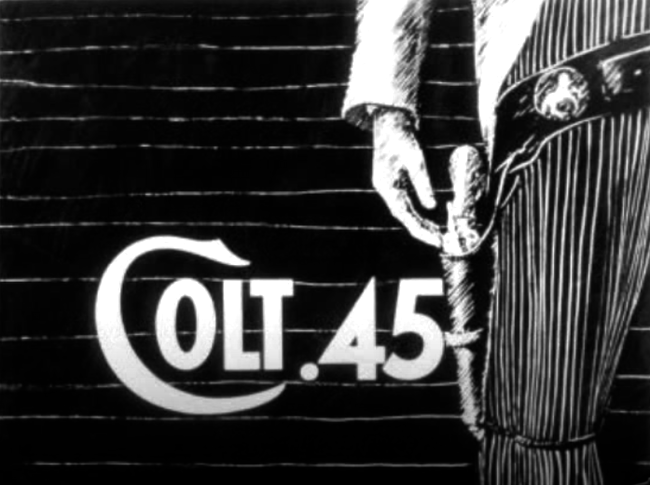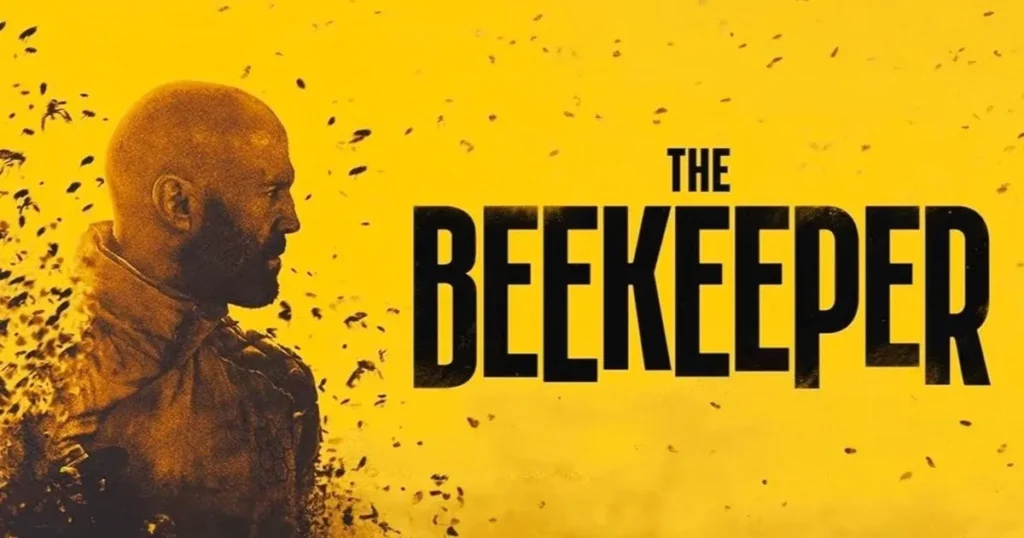Colt .45 has been somewhat of a holy grail title for television on disc enthusiasts. While all manor of classic shows came into print during the golden age of DVD, this title remained elusive, no longer even in syndication. After decades of unavailability, a new 4K-sourced restoration from Warner Archive has resulted in a new Blu-ray release, allowing this long-out-of-view show to be freshly appraised.
The Production: 4/5
Colt .45 has been somewhat of a holy grail title for television on disc enthusiasts. While all manor of classic shows came into print during the golden age of DVD, this title remained elusive, no longer even in syndication. After decades of unavailability, a new 4K-sourced restoration from Warner Archive has resulted in a new Blu-ray release, allowing this long-out-of-view show to be freshly appraised.
Over the course of three seasons, including a retooling in the third season to swap one main character for another, Colt .45 provided a total of 67 half-hour episodes that adhere pretty closely to a tried-and-true formula. In the first two seasons, Christopher Colt (played by Wayde Preston) travels from town to town across the Old West, disguising himself as a gun salesman to obscure his actual identity as an undercover agent sent to dispatch law and order in places lacking it. When the series begins, it seems as though most episodes will be as simple as Colt arriving in a new town, first trying to use peaceful means to settle matters, but ultimately being compelled to use his skill as a quick draw to neutralize the threat. But as the series gets underway, there starts to be a greater variety of situations that Colt is drawn into, with resolutions that involve more than just shooting. The show attempted to show a little more intelligence regarding its use of violence than the average production, with the first episode beginning with a prescient exchange debating whether guns kill people or whether people kill people. (To the pilot’s credit, it rejects the sloganeering in favor of a more nuanced exploration of those themes.)
The show might not be as deeply felt as Have Gun-Will Travel, arguably the pinnacle of this type of western, but there’s a bit more going on here than a cursory glance might suggest. Sometimes the villains and supporting characters would be entirely fictional creations, while other times they were drawn from history. The show had the opportunity to cover a lot of different ground given its format, and it took advantage of those opportunities. Notable guests included up-and-coming future stars like Charles Bronson, Angie Dickinson, Leonard Nimoy and Adam West, as well as television stalwarts like Lyle Talbot and Robert Conrad, and even baseball legend Sandy Koufax.
After a second season truncated due to issues with leading man Preston, the final season saw Donald May joining the cast mid-year as Sam Colt, Jr., a cousin of Preston’s character. May is a square-jawed leading man more than capable of carrying the show, and the show’s format allowed for the switch without needing to provide a lengthy explanation. (Accounts vary as to why Preston was difficult to work with, though one frequently cited explanation was that Preston was reluctant to perform difficult stunts better suited for a professional stuntman.) Though the switch from Preston to May stabilized the production process, it did little to reverse a decline in ratings, and the show exited the airwaves after the conclusion of the the third season without much fanfare. But before the show wrapped up, it did bring Preston back in a more limited capacity, which allowed for some enjoyable on-screen camaraderie between Preston and May. (It was even retitled as The Colt Cousins for UK audiences.)
While Colt .45 doesn’t quite excel to the heights of the gold standards of that period, it is a great example of television craftsmanship of its era. At his best, Preston’s Colt presents a harder edge but is given quiet moments to hinting at a wider and gentler range that the show might have benefitted from including more of. The variety of backlot sets and locations available to the production give it an appropriately convincing atmosphere, and the occasional use of stock footage enhances rather than detracts from the show. Looking back at this 1957-1960 production from today’s perspective makes one appreciate the virtues of episodic storytelling, with easily identifiable heroes and villains and stories that tell a complete beginning, middle and ending in under thirty minutes. If there is a shortcoming here, it’s that episodic television lives or dies on the charisma of its leading player(s) and the characters they fold their personas into, and as adequate as Preston and May are, they lack the intangibles that make the best leading men timeless. (Not everyone can be Paladin, I suppose.) A more compelling performance and a more deeply drawn lead character could have elevated the show beyond what it is, but what is here should be more than enough to anyone looking for a little bit of escapism, one half hour at a time.
Ultimately, assigning a numerical rating to any review is often the hardest part of the assignment. While this show doesn’t quite transcend its era in a way evergreens like I Love Lucy or The Twilight Zone have, fans of classic 1950s-era television shows, particularly westerns, can safely add at least half a star, if not a full one, to this review.
The discs are split between three keepcases (one for each season), housed in a nice cardboard box. Season one contains four discs, season two is on two discs, and season three is again four discs. Warner Archive is to be commended for clearly labeling each disc’s episode titles and original airdates on the back of each season’s case.
Video: 5/5
3D Rating: NA
Sourced from brand-new 4K scans of the original camera negative, Colt .45 is presented in its original television aspect ratio of 1.33:1, and the presentation is nothing short of breathtaking. This release instantly becomes the best looking western show from the golden age of television ever presented on disc. The video is pristine, with nary a blemish or age-related defect in sight, also free of any signs of any untoward digital manipulation. The black and white photography is crisp and rock steady, with good detail all around that serves to reinforce the atmosphere of the series rather than revealing the tricks behind its creation. While the show’s aesthetic choices tend to be more paint-by-numbers than innovative (as one would reasonably expect from a weekly show filmed on the lot), watching these new transfers is like stepping through a window into television history. If only every 1950s-era TV show looked half as good today as this one does.
Audio: 5/5
Presented via the lossless DTS-HD MA codec, the original monaural soundtrack is beautifully reproduced here, every part the equal of the visual presentation. Dialogue is always clear and easily intelligible, and the sound effects and music cues and end title song all sound wonderfully rich and detailed without overwhelming the track. There is not even a hint of age-related wear-and-tear, but neither is there any sign of untoward digital manipulation.
Optional English SDH subtitles are also included.
Special Features: 0/5
It’s slightly disappointing that no special features were included in this release, but not unexpected given that Warner Archive rarely creates new bonus material. Still, it does seem like a missed opportunity not to have a short featurette on the remastering of a show that’s been out of circulation for decades, and a commentary on an episode or two could have offered insight on the show’s troubled production. Even if Warner Archive was unable to create new bonus material, it’s too bad that some existing tie-ins weren’t included. (The Christopher Colt character crossed over onto Warner’s Sugarfoot series, and Preston made a notable guest appearance on the studio’s series Maverick; these also would have been worth considering for inclusion in this set.)
Overall: 4.5/5
Warner Archive’s surprise venture in classic television on Blu-ray has yielded what is arguably the best technical presentation ever for a 1950s-era show on home video. While Colt .45 itself doesn’t break new ground, it has long been desired by fans of classic westerns due to decades of unavailability, and the joys of seeing these half hours of escapism presented so well more than makes up for the show’s more formulaic aspects. Setting a new standard for the technical presentation of a 1950s show on disc, one can only hope that this is the first of many such releases from Warner Archive.
Josh’s fate as a physical media enthusiast was probably sealed the moment he figured out how to operate a top-loading VCR before he even knew how to walk. Since graduating with a degree in film production, he has enjoyed a career focused on the archival and distribution side of film and television. These days, Josh thinks of himself as a proud father of twins first. He would like to thank his wife for her unwavering support, and for every typo she’s ever caught.
Post Disclaimer
Some of our content may contain marketing links, which means we will receive a commission for purchases made via those links. In our editorial content, these affiliate links appear automatically, and our editorial teams are not influenced by our affiliate partnerships. We work with several providers (currently Skimlinks and Amazon) to manage our affiliate relationships. You can find out more about their services by visiting their sites.





Similar threads
- Josh Steinberg
- TV on DVD and Blu-ray
2- justarandomstan
- TV on DVD and Blu-ray
12 13 14 Tags warner archive- Matt Hough
- TV on DVD and Blu-ray
2- Josh Steinberg
- TV on DVD and Blu-ray
2